Holochain is a project that many say is set to change the way we think about Distributed Ledger Technology. As a result, interest in HOT is at a fever pitch.
Indeed, Holochain is offering an alternative to the current landscape of bloated blockchains and imperfect solutions. However, the project is facing questions of its own including why development is progressing so slowly, months after a highly successful ICO.
So, is it still a project worth considering?
In this Holochain review I will attempt to answer that. I will also take an in-depth look at the use cases of the HOT token and it's long term adoption potential.
What is Holochain?
Holochain is being positioned as an alternative to the blockchain, giving developers a framework for creating decentralized applications (dApps).
One huge change to enable this is a switch from the data dependent blockchain to an agent-centric system. Holochain's method avoids keeping a global consensus, using an agent system in which each agent keeping a private fork, and that is stored and managed in a limited manner on the blockchain with a distributed hash table.

This avoids scalability problems that have plagued blockchain solutions. It also allows any dApps hosted on Holochain to do far more with less resource than required for blockchains. In this Holochain review, we will take an in-depth look at the project, technology and token prospects.
Holochain vs. Blockchain
The traditional blockchain works by storing data via cryptographic hashes on a distributed network. Each node on that network maintains a full copy of the blockchain and the global consensus to verify the network and keep its integrity intact. It's one feature of blockchain technology that has been a strength of the emerging technology.
There are weaknesses that come with the blockchain methodology. One that has been plaguing blockchain developers is scalability issues that are created by requiring each node in the network to verify the entire network.
As the amount of data increases on the blockchain, it becomes increasingly restrictive for transaction throughput on the blockchain. This is why some cryptocurrencies have experienced such long transaction times, and such high network fees.
The name came about because the system used by Holochain resembles the construction of a hologram. In a hologram a coherent 3-D pattern is created by a specific interaction of light beams, and in the Holochain the system creates a coherent whole in a similar manner, putting individual components together to form a whole.
In addition, the technology uses holistic patterns as part of its functionality.
The Public Portion Blockchain
The Holochain system does away with scalability issues by not requiring each node or agent on the network to keep a continually updated record of the entire public blockchain.
Instead, each node keeps its own blockchain which interacts with the node's unique cryptographic key. Imagine the entire public blockchain as a river, and each node is similar to a smaller stream that feeds into the river.
If a node goes offline it creates a fork of the public chain, but the public chain continues forward, without being impacted by the loss of one of its nodes.
Holochain is a Green Solution
By now everyone knows how much energy is required by Proof of Work blockchains such as Bitcoin. Holochain claims to be a green solution to environmentally destructive blockchains.
Because nodes on Holochain don’t store and validate the entire blockchain there is only a small percentage of bandwidth used in comparison with traditional blockchains.
Moreover, there’s no mining component to Holochain, so the electricity used is minimal, really no more than would be used by the node computers in their normal operations. With the electricity requirements of PoW blockchains constantly on the rise, this environmentally friendly approach seems far better.
Node Data Accessed by the Public Space
Instead of making each node keeps its own copy of all the data in the entire blockchain, the Holochain central chain maintains a series of rules to verify the data on each node's blockchain. That verification occurs occurs on a distributed hash table.
This means that when a node goes offline its data is not lost to the public blockchain. Instead a limited copy is maintained and verified according to the set of rules.
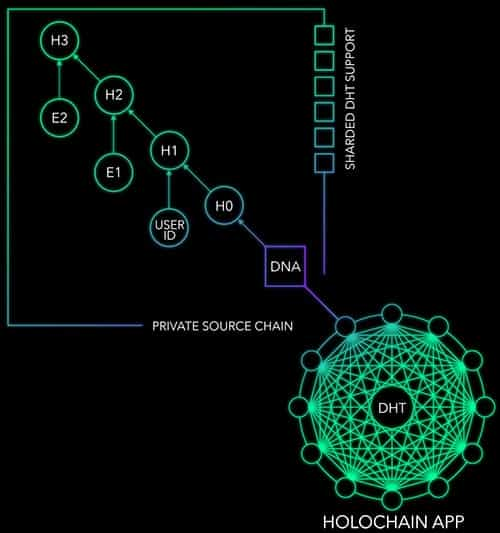
As you can read in the FAQ section of the Holochain website, the developers compare the system to the way that a living organism stores information in DNA or the way that languages are stored by populations of people.
“Where is the English language stored?” the Holochain developers ask in the FAQ. “Every speaker carries it. People have different areas of expertise or exposure to different slang or specialized vocabularies. Nobody has a complete copy, nor is anyone’s version exactly the same as anyone else, If you disappeared half of the English speakers, it would not degrade the language much.”
How Scalable is Holochain?
The question of how many transactions per second Holochain can handle needs to be looked at differently than the way we look at scalability on traditional blockchains.
The quick answer to the question is that scalability is unlimited on Holochain. That's somewhat simplistic, and honestly the idea of transactions per second doesn't apply to Holochain due to its inherent nature.
Rather than keeping a global consensus of data on the blockchain, Holochain uses a distributed hash table to keep a record of the essential type and validity of data that each individual node contributes.
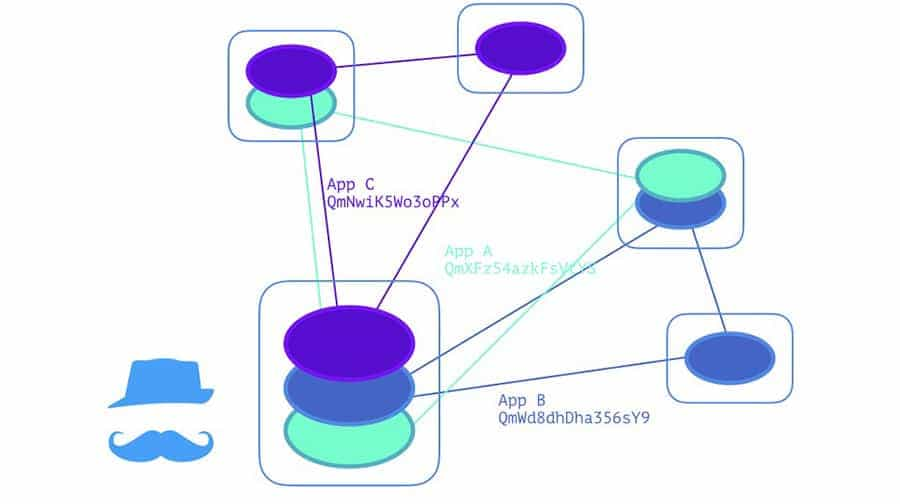
Network topology of five agents running three different apps. Every app is it’s own p2p network. Source
The developers have used an analogy of a dance floor to better explain. You can look at a dance floor and immediately know who is dancing ballet and who is dancing hip-hop.
How many dancers can be dancing at the same time?
As many as will fit on the dance floor. It's apparent that there's no need to use a trusted centralized third-party to keep track of the dancers and what style of dance they are performing.
“So, Holochain as an app framework does not pose any limit of transactions per second because there is no place where all transactions have to go through,” the developers wrote. He went on to say
It is like asking, ‘How many words can humanity speak per second?’ It's an irrelevant question. With every human being born, that number increases. Same for Holochain.
What Dapp's Work With Holochain?
Holochain would be a very good fit for any dApps that require a large number of individual inputs where each individual has access to a limited copy of all the inputs.
The immediate use case put forth by Holochain is social media platforms, but they’ve also suggested that Holochain will work well in peer-to-peer platforms, supply chain management, reputational cryptocurrencies or loyalty programs, collective intelligence projects and more.
These projects make a good fit for Holochain because of its agent-centric nature. You can also view a comprehensive overview of the types of apps you can develop on the holohackers map.
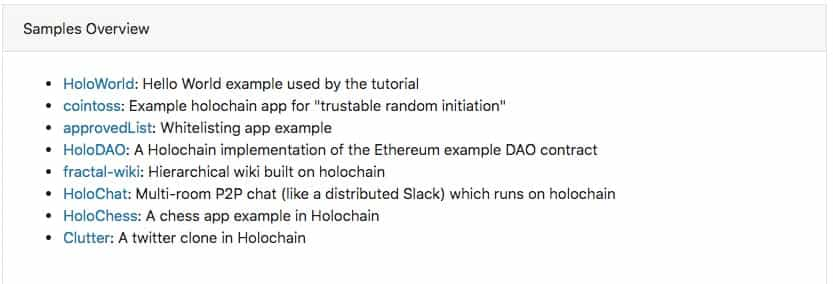
Holochain would not work well with any type of private or anonymous datasets however, since each individual node publishes a shared distributed hash table. Holochain is also not suited for any application that hosts large files, or for running data positivist-oriented dApps, like most cryptocurrencies.
The vision adopted by Holograph postulates that there are no absolute truths on the public blockchain, only the individual perspective held by each node that can be brought together to form a larger picture. This has been compared to a blockchain vision of the theory of relativity.
Language Support
Holochain was written in Go, and that particular programming language was chosen for its similarity to C and its ease of use. The code base is fully open source and can be examined at the Holochain GitHub.
When developing dApps for Holochain developers are free to use both Lisp and JavaScript and there is also support for front-end languages such as CSS, HTML and JavaScript.
The Holochain developers have stated that Holochain is flexible in regards to handling new languages, so there is a good possibility that support for additional languages will be added in the future.
The Holochain Team
The developers behind Holochain have a vast amount of experience. The co-founders both have 34 years of programming experience. Arthur Brock, who is the Chief Architect behind Holochain has been a contract coder since 1984, working with AI systems and as an online alternative currency system designer since 2001.

Eric Harris-Braun is the Executive Engineer behind Holochain. He has also been a contract coder since 1984, a full time programmer since 1988, a designer of peer-to-peer communication applications (glassbead.com) for many years, a full-stack web developer, as well as having experience in system design, framework design, etc.
Rounding out the team are 12 additional developers, UX/UI experts, and software engineers. The core developers are David Meister, an Australian software architect with over a decade of experience, and Nicolas Luck, a German software architect who also has over a decade of experience developing elegant software solutions.
Adoption and Community
Possibly because the community is still waiting for the release of the Holochain mainnet, the adoption and community activity isn’t quite what you see from some other projects.
The sub-Reddit for Holochain has just under 7,000 subscribers, but posts are only made every few days on average, and many of the recent posts have no responses or comments.
The development team remains active on Reddit though, with AMA’s and explorations of various team members, community leaders, and features of the platform.
Twitter is another popular social platform in the crypto-world, and Holochain is active there, with almost 30,000 followers. They tweet regularly, and most tweets get about 100 likes, and 20-30 retweets.
The Telegram channel of Holochain is fairly large, with just over 12,500 members, and the Holochain Facebook page has over 5,000 likes. There’s also a Holochain Forum, but it doesn’t appear to be exceptionally busy, with only 1-2 posts a day.
Holochain Token (HOT)
Holochain completed a month long ICO on April 28, 2018 during which they raised a bit over 30,000 ETH worth roughly $20 million at the time. There were 133,214,575,156 HOT tokens minted for the ICO. As of October 21, 2019 the HOT token is trading for 0.000950, and has a market capitalization of over $150 million, making it the 37th largest cryptocurrency by market cap.
Immediately following the ICO the token had traded as high as $0.002 for a more than 1,000% gain in a week. The price quickly deflated over the following two months, and by July 2018 was trading below $0.0005.
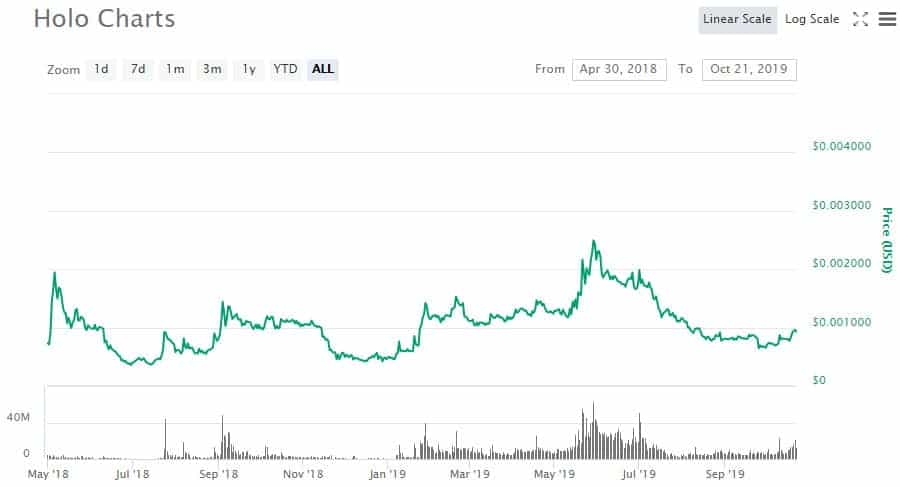
HOT Price Performance. Image via CMC
Like all the coins in the cryptocurrency markets, HOT has had its ups and downs over the years, trading as low as $0.000341 on June 29, 2018 and as high as $0.002538 on May 29, 2019.
The HOT token is an ERC-20 token that can be stored in any ERC-20 compatible wallet, such as MetaMask, MyEtherWallet, or one of the hardware wallets. Eventually, the ERC-20 tokens will be able to be swapped for Holofuel. That swapping will become available once the Holo mainnet launches.
Rather than burning the HOT tokens after swapping they will be held in a reserve account to help maintain stability in the network. There are no plans yet for when HOT will be completely removed. There are also no set plans for listing Holofuel on exchanges, although the team understands this conversation will need to happen.
HOT Trading
When it comes to the markets for HOT, it is listed on a number of exchanges. These include the likes of CoinEx, Binance, MXC etc. The volume is seems to be pretty well distributed although CoinEx has over 30% of it.
When it comes to the liquidity on the individual exchanges, it appears to be pretty strong. For example, if we were to take a look into Binance's USDT / HOT order book it appears to be quite deep. There is also pretty reasonable daily turnover.

Register at Binance and Buy HOT Tokens
In addition to this, the Binance Exchange also makes a market in BTC & ETH crosses of HOT. So, this means that you will be able to place large block orders without too much slippage.
What is Holofuel?
Holofuel is the planned native cryptocurrency of Holochain, which will be a mutual-credit currency, and will be backed by actual assets.
The Holochain team calls it a “contractual service obligation” because it can be earned and redeemed for hosting on the Holochain platform. Its primary use is for Holochain application (hApp) providers to pay Holo hosts for their services.
The Holochain team believes Holofuel is different from many of the existing cryptocurrencies for three primary reasons:
- Mutual Credit: Unlike other cryptocurrencies which are primarily used for speculation, HoloFuel is not tokens created from nothing. It is a double-entry crypto-accounting framework that provides scalability, transparency, and accountability.
- Asset-Backed: HoloFuel is backed by the computing power of hosts across the globe.
- Value-Stable: The value of HoloFuel is connected to the computing capacity of the network of hosts. This capacity evolves and changes slowly and isn't subject to huge spikes and crashes the way other speculative tokens are.
Ultimately this makes Holofuel a hosting utility token, and there are already several competitors who are much further along in development. Projects like Sia, Storj and Filecoin all reward users for sharing their computing power, harddrive space or bandwidth capacity.
Development
I will also mention here that there have been some criticisms of Holochain, most notably that the project is making little to no progress.
And it’s true the project has been progressing quite slowly. It is still waiting for the alpha testnet to launch 18 months after the ICO was completed.
That’s a long time, and there’s no indication when the mainnet might launch. Of course, the team says they’re taking a long view towards their project, and that they don’t want to rush anything.
Of course, there is a simple way to assess the monthly development output and that would be to take a look into their code public code repositories. By observing the code commits we can get a good idea of how much work is actually being done.
Hence, I decided to dive into the HoloChain GitHub and check out their repositories. Below you have the total code commits for the top 3 most active repos over the past 12 months.
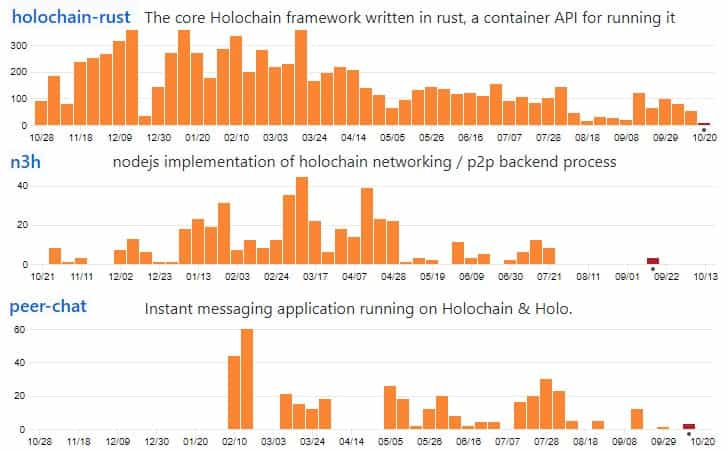
As you can see, the developers have indeed been quite active. There have been regular commits to all of these select repos over the past year. The project also has over 100 further repositories with varying levels of activity - quite impressive.
If we were to compare this to other projects it's quite clear that Holochain is amoung the most active of all. In fact, on this site they are ranked number 2 when it comes to commits to their core repo.
So, although there have been delays in getting the testnet up and running, one can't complain that the team is not working towards it. If you want to keep up to date with this development you can follow their official blog.
Conclusion
We’ve been told that Bitcoin and blockchain are the future technology, but this might not be entirely true. Blockchain technology is actually nearly 10 years old already, and top cryptocurrencies do little more than mimic our existing corrupt financial system in a quasi-decentralized fashion.
Bitcoin is meant for storing value, and has also become something of a casino for traders. Holochain will be a system of value creation and community engagement that is designed to help us get to a post-monetary society based on community, personal contributions, merit, and service to others. It was designed to grant both data and personal integrity.
It’s not certain if Holochain will be successful, but it is ready to be used, and developers can already begin building the applications they feel can help change our society and our world. Some examples of Holochain dApps can be found here and if you’re interested in developing your own dApp with Holochain you can get started here.
Investors have done very well already with the token seeing a 500% increase from its ICO, and that was during a bear market in crpytocurrencies. Once Bitcoin and other cryptocurrencies begin rising again the HOT token could see significant upside.
Disclaimer: These are the writer's opinions and should not be considered investment advice. Readers should do their own research.
Disclaimer: These are the writer’s opinions and should not be considered investment advice. Readers should do their own research.


